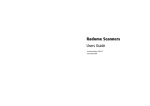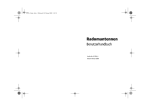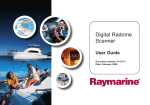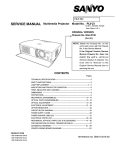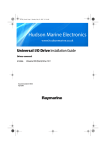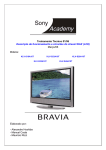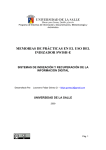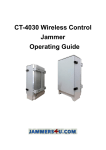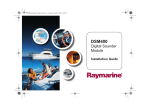Download Raymarine Radome Scanners Product specifications
Transcript
Radome Scanners Users Guide Document Number: 81256_4 Date: June 2006 Trademarks and registered trademarks Autohelm, HSB, Raymarine, RayTech, RayTech RNS, Sail Pilot, SeaTalk and Sportpilot are registered trademarks of Raymarine Limited. Apelco is a registered trademark of Raymarine Holdings Limited (Registered in all major marketing territories). AST, Autoadapt, Auto GST, Autoseastate, Autotrim, Bidata, Marine Intelligence, Maxiview, On Board, Raychart, Raynav, Raypilot, Raystar, ST40, ST60, Seaclutter, Smart Route, Tridata and Waypoint Navigation are trademarks of Raymarine Limited. All other product names mentioned are trademarks or registered trademarks (if applicable) of their respective companies. © Raymarine UK Ltd 2006 Contents i Contents Important information ................................................................1 Introduction........................................................................................... 1 Intended use ......................................................................................... 1 Safety notices ........................................................................................ 1 WARNING: High voltage............................................................1 WARNING: Electromagnetic energy........................................1 WARNING: Product installation ...............................................1 Waste Electrical and Electronic Directive............................................... 2 EMC conformance ................................................................................. 2 Declaration of conformity...................................................................... 2 Display software version ....................................................................... 2 Warranty ............................................................................................... 2 Handbook information .......................................................................... 2 Installation ....................................................................................3 EMC installation guidelines................................................................... 3 Suppression ferrite............................................................................. 3 Connections to other equipment ....................................................... 3 What’s in the box? ................................................................................ 4 What tools do I need to install the scanner? ..................................... 4 How big is the scanner? ........................................................................ 5 18” Radome scanner ......................................................................... 5 24” Radome scanner ......................................................................... 5 Planning the installation ....................................................................... 6 Cable requirements ............................................................................... 7 Scanner cables ...................................................................................... 7 Running the cable to the scanner ...................................................... 7 Inter-unit cables................................................................................. 7 Power cables ......................................................................................... 8 Extending the power cable ................................................................ 8 Power requirements........................................................................... 8 Extending the power cable.................................................................... 9 Mounting options................................................................................ 11 Preparing the mounting holes ............................................................. 11 Securing the scanner to the mounting platform .................................. 12 Connecting the inter-unit cable to the scanner ................................... 13 Completing the installation ................................................................. 14 Display connections............................................................................. 15 Power connections........................................................................... 15 Inter-unit cable connections ............................................................ 16 Scanner setup...................................................................................... 16 Before you go to sea........................................................................ 16 EMC conformance............................................................................ 16 System checks.................................................................................. 16 Set up, alignment and timing checks ............................................... 17 Maintenance and troubleshooting ..........................................19 Introduction ..................................................................................... 19 Maintenance.................................................................................... 19 Troubleshooting............................................................................... 19 Technical support............................................................................. 20 Technical specification.............................................................. 21 RD218 18”Radome scanner unit ........................................................ 21 RD424 24”Radome scanner unit ........................................................ 23 ii Radome Scanners - Users Guide Important information 1 Important information Introduction Safety notices This handbook contains an explanation of how to install, connect and maintain your radome scanner and covers the following models: • RD218 - 18” 2kW Radome scanner. • RD424 - 24” 4 kW Radome scanner. Your radar has been designed and manufactured to meet the rigorous demands of the marine environment. However, no machine can perform its intended function unless installed, operated and maintained properly. Please carefully read and follow the recommended procedures for installation contained in this handbook. When properly installed and operated, the use of this radar will conform to the requirements of: • • IEEE C95.1 - 1999 - Standard for Safety Levels with respect to Human Exposure to Radio Frequency Electromagnetic Fields, 3 kHz to 300GHz. ICNIRP Guidelines 1998 - International Commission on Non-Ionising Radiation Protection: Guidelines for limiting exposure to time-varying electric, magnetic and electro-magnetic fields (up to 300GHz) 1998. WARNING Radio Frequency Radiation Hazard The radar antenna emits electromagnetic radio frequency (RF) energy which can be harmful particularly to your eyes. DO NOT look at the antenna at close range. It is important that the radar is turned off whenever personnel are required to come close to the scanner assembly or associated equipment. It is recommended that the radar scanner is mounted out of range of personnel (above head height). Distances from the face of the radar at which RF radiation levels of 100 W/m2 and 10 W/m2 exist are given below Model Distance to 100 W/m2 point Distance to 10 W/m2 point RD218 Nil Worst case 1.0m RD214 Nil Worst case 1.0m Intended use This product is a radar scanner intended for use within a navigational radar system. The intended application is for leisure marine boats and work boats not covered by IMO/SOLAS carriage requirements. 2 Radome Scanners - Users Guide WARNING High Voltage The scanner unit contains high voltages. Adjustments require specialized service procedures and tools only available to qualified service technicians - there are no user serviceable parts or adjustments. The operator should never remove the scanner unit internal covers or attempt to sevice the equipment. WARNING Product installation This equipment must be installed in accordance with the instructions contained in this handbook. Failure to do so could result in poor product performance, personal injury and/or damage to your boat. Waste Electrical and Electronic Equipment Directive The Waste Electrical and Electronic Equipment (WEEE) Directive requires the recycling of waste electrical and electronic equipment. Whilst the WEEE Directive does not apply to some of Raymarine’s products, we support its policy and ask you to be aware of how to dispose of this product. The crossed out wheelie bin symbol, illustrated above, and found on our products signifies that this product should not be disposed of in general waste or landfill. Please contact your local dealer, national distributor or Raymarine Technical Services for information on product disposal. EMC conformance All Raymarine equipment and accessories are designed to the best industry standards for use in the recreational marine environment. The design and manufacture of Raymarine equipment and accessories conform to the appropriate Electromagnetic Compatibility (EMC) standards, but correct installation is required to ensure that performance is not compromised. FCC Notice Declaration of conformity Changes or modifications to this equipment, not expressly approved in writing by Raymarine Inc., could violate compliance withFCC rules and void the operator’s authority to operate the equipment. Raymarine UK Limited hereby declare that the products to which this manual relates comply with the appropriate requirements and provisions of the R&TTE Directive 1999/5/EC. The full Declaration of Conformity may be viewed on the relevant product pages at www.raymarine.com Important information Display software version For operation of your scanner, the display unit requires the appropriate software version. These are: • E Series displays - Version 3.03 or later. • C Series displays - Version 3.01 or later. The software version can be confirmed by switching on the display and checking the version number during the magnetron warm-up sequence. However, if a scanner is not connected to the display, the version number will only be displayed for 10 seconds. Warranty To register your new Raymarine product, please take a few minutes to fill out the warranty card. It is important that you complete the owner information and return the card to receive full warranty benefits. Alternatively you can register your product on line at www.raymarine.com Handbook information The technical and graphical information contained in this handbook, to the best of our knowledge, was correct as it went to press. However, our policy of continuous improvement and updating may change product specifications without prior notice. As a result, unavoidable differences between the product and handbook may occur from time to time. 3 4 Radome Scanners - Users Guide Installation 5 Installation EMC installation guidelines All Raymarine equipment and accessories are designed to the best industry standards for use in the recreational marine environment. Their design and manufacture conforms to the appropriate Electromagnetic Compatibility (EMC) standards, but correct installation is required to ensure that performance is not compromised. Although every effort has been taken to ensure that they will perform under all conditions, it is important to understand what facts could affect the operation of the product. The guidelines here describe the conditions for optimum EMC performance, but it is recognized that it may not be possible to meet all of these conditions in all situations. To ensure the best possible conditions for EMC performance within the constraints imposed by any location, always ensure the maximum separation possible between different items of electrical equipment. For optimum EMC performance, it is recommended wherever possible: • • Raymarine equipment and cables connected to it are: • At least 3 ft. (1m) from any other equipment transmitting or carrying radio signals. In the case of Single Side Band (SSB) radio, the distance should be increased to 7 ft. (2m). • More than 7 ft. (2m) from the path of a radar beam. A radar beam can normally be assumed to spread 20 degrees above and below the radiating element. The equipment is supplied from a separate battery to that used for engine start. Voltage drops below 10 V, and starter motor transients, can cause the equipment to reset. This will not damage the equipment, but may cause the loss of some information and may change the operating mode. • Raymarine specified cables are used. Cutting and rejoining these cables can compromise EMC performance and must be avoided unless doing so is detailed in the installation manual/ Suppression ferrite If a suppression ferrite is attached to a cable, this ferrite should not be removed. If the ferrite needs to be removed during installation it must be reassembled in the same position. D8852_1 The illustration shows typical cable suppression ferrites used with Raymarine equipment. Always use the ferrites supplied by Raymarine. Connections to other equipment If your Raymarine equipment is to be connected to other equipment using a cable not supplied by Raymarine, a suppression ferrite MUST always be attached to the cable near to the Raymarine unit. 6 Radome Scanners - Users Guide What’s in the box? What tools do I need to install the scanner? Adhesive tape Radome Scanner Drill Torque wrench Artwork Number 3032-866-A 3026-136-A Center Line of Radome 10 mm drill bit Forward 13 mm socket 233 mm Fixing bolts and washers X4 Drill 4 holes, 10 mm diameter (18'' and 24'' Radomes) Inter-unit cable Center Line of Radome 18'' or 24'' NGS Radome Mounting Template 27.5 mm Installation template Components are dependant on your system package, but are either: • • • • • 18” 2 kW Radome scanner and 15 m light cable, or 24” 4 kW Radome scanner and 15 m heavy cable. Fixing bolts and washers. Grease. Handbook. Philips screwdriver D8853_1 141.5 mm Grease D8854_1 Installation 7 How big is the scanner? 24” Radome scanner 247 mm (9.7 in) 521 mm (20.5 in) diameter 652 mm (25.67 in) diameter 27.5 mm (1.08 in) 141.5 mm (5.57 in) D8567-1 D8566-1 27.5 mm (0.92 in) 141.5 mm (5.57 in) 233 mm (9.17 in) 346 mm (13.62 in) diameter 116.5 mm (4.58 in) 346 mm (13.62 in) diameter 233 mm (9.17 in) 116.5 mm (4.58 in) 247 mm (9.7 in) 18” Radome scanner 8 Radome Scanners - Users Guide Planning the installation 12.5˚ 12.5˚ D8856_1 Mount the scanner so that the array rotates parallel to the waterline. The radar beam is approximately 25o wide in the vertical direction, giving good target detection when your boat pitches and rolls. D8855_1 Mount the scanner as high as possible above the waterline for better long range performance, but make sure it: • • • • • is above head height. is easily accessible. is as near to the boat’s centerline as possible. is on a rigid and stable platform. is clear of large objects such as the flybridge, large engine stacks, searchlights, horns or masts. • is clear of heat and fumes. • is at least 1 m away from a magnetic compass or other equipment antenna. Don’t put the scanner so high, that it is affected by the pitching and rolling of the boat. Planing hull and some displacement hull boats adopt a higher bow angle when the boat is at Forward cruising speed., giving poor target detection. D8857_1 It may be necessary to lower the radar beam back towards the parallel, by shimming the rear of the radar, so that the beam points slightly down when the boat is at rest. Wedge or washers Installation 9 Inter-unit cables You need to consider the following points before installing the system cables: The inter-unit cable, illustrated below, is fitted with an 8-way plug and power cores (covered with a clear protective sleeve) for connecting to the scanner. • • • • • You need to connect the scanner to the display unit and power. The cable required will depend on the display unit and scanner type. All cables should be adequately clamped and protected from physical damage and exposure to heat - avoid running cables through bilges or doorways, or close to moving or hot objects. Acute bends must be avoided. Where a cable passes through an exposed bulkhead or deckhead, a watertight gland or swan neck tube should be used. Avoid cutting and rejoining cables. If this cannot be avoided refer to Extending the power cable on page -11. Scanner cables A radome scanner connected to a C or E-Series display receives power via the display unit. Running the cable to the scanner DO NOT pull the cable through bulkheads using a cord attached to the connector. This could damage the connections. The cable entrance is at the rear of the scanner unit. If the unit is mounted on a hollow mast, the cable may be run inside the mast and fed though the unit’s cable entrance. Make sure that the cable does not chafe where it enters and exits the mast. To minimize electrical interference try to avoid running radar cables near other on board electrical equipment. It is also good practice to avoid running radar cables in parallel with power cables. To display or extension (power supplied via display unit) To Radome Scanner D8858_1 Cable requirements The length of the cable supplied should be sufficient to complete the cable run on most small boats. For longer runs, additional or replacement cables are available. These cables have four power cores to minimize voltage drops over the longer cable run. Optional cable lengths available are: • Part No. M92668 - 15 m heavy extension cable. • Part No. M92669 - 25 m heavy replacement cable. The maximum inter-unit cable length is limited by the minimum supply voltage, the scanner type (18” or 24 “radome), and the cable type (2 or 4 power cores). For boats with 12 V DC power systems details of recommended cable(s) for different run lengths can be found in Extending the power cable on page -11. Boats with 24 V DC power systems can use any combination of inter-unit cables. 10 Radome Scanners - Users Guide Power cables Radome radar systems are intended for use on boat’s DC power systems operating in the range 10.7 to 32 V DC. That is 12 V and 24 V systems, they should not be used on 32 V systems. A 1.5 m (5ft) power cable is supplied with the display unit for connecting the boat’s DC power to the radar scanner via the display unit.Refer to the relevant display unit handbook for details on connecting this cable. Extending the power cable 24 V power systems If your boat has a 24 V power system, the power cable may be extended by up to 20 m using a wire gauge of 1.5 mm2 (AWG 16) or greater, irrespective of the inter-unit cable length. 12 V power systems If your boat has a 12 V power system, longer power cable runs may require larger wire gauges to minimize any voltage drop in the cable. For full details on extending the power cable and maximum permissible lengths refer to Extending the power cable on page -11. Power requirements This radar is not recommended for use on ‘positive’ ground boats. The power cable earth screen must be connected to the boat’s ground. The boat’s power system should be either: • • Negative grounded, with the negative battery terminal connected to the boat’s ground, or, Floating with neither battery terminal connected to the boat’s ground. Radome scanners receive power from the display via the inter-unit cable. The display power cable is supplied with the display unit and details for connecting power are detailed in the relevant Owner’s handbook. Grounding the radar system It is important that an effective radio frequency (RF) ground is connected to the radar system. You must ground the radar by connecting the drain wire (screen) of the power cable to the nearest ground point of your boat’s RF ground system. Full details can be found in the Owner’s Handbook for your display unit. If you need to extend the wire, the extension wire should be an 8 mm braid or 6 mm2 (AWG 10) multi-strand cable. If your boat does not have an RF system, connect the drain wire to the negative battery terminal. 11 Extending the power cable 12 V systems - Maximum permissible length for extending a power cable (m) Inter-unit cable type Display type Power cable core (each core) 1.5 16 mm2 AWG Radome size (ins) 10 m light 10 m light + 5 m ext 10 m light + 10 m ext 2.0 15 2.5 14 15 m heavy 6.0 10 10 7 18 24 18 24 18 24 18 24 18 24 18 24 C-Series (6.0) N/A (7.0) N/A (9.0) N/A 18.0 N/A 24.0 N/A 47.0 N/A E-Series (2.0) N/A (3.0) N/A (3.0) N/A 7.0 N/A 9.0 N/A 18.0 N/A C-Series (4.0) N/A (5.0) N/A (6.0) N/A 12.0 N/A 16.0 N/A 31.0 N/A E-Series (2.0) N/A (2.0) N/A (3.0) N/A 6.0 N/A 8.0 N/A 16.0 N/A C-Series (1.0) N/A (2.0) N/A (2.0) N/A 5.0 N/A 6.0 N/A 13.0 N/A E-Series 15 m light 4.0 11 DO NOT EXTEND THE POWER CABLE C-Series (3.0) N/A (3.0) N/A (4.0) N/A 9.0 N/A 11.0 N/A 23.0 N/A E-Series (1.0) N/A (2.0) N/A (2.0) N/A 5.0 N/A 6.0 N/A 13.0 N/A C-Series (6.0) (4.0) (8.0) (6.0) (11.0) (7.0) 21.0 14.0 27.0 19.0 50.0 37.0 E-Series (2.0) (1.0) (3.0) (2.0) (4.0) (2.0) 8.0 5.0 10.0 7.0 20.0 14.0 12 Radome Scanners - Users Guide Inter-unit cable type 15 m heavy +5 m ext Display type Power cable core (each core) C-Series (6.0) (4.0) (8.0) (5.0) (10.0) (6.0) 20.0 13.0 26.0 17.0 50.0 34.0 E-Series (2.0) (1.0) (3.0) (2.0) (4.0) (2.0) 7.0 5.0 10.0 6.0 20.0 13.0 15 m heavy + C-Series 10 m ext N/A (3.0) N/A (4.0) N/A (5.0) N/A 11.0 N/A 14.0 N/A 28.0 E-Series N/A (1.0) N/A (1.0) N/A (2.)0) N/A 4.0 N/A 6.0 N/A 12.0 C-Series (6.0) (3.0) (8.0) (4.0) (10.0) (6.0) 20.0 11.0 25.0 15.0 50.0 29.0 E-Series (2.0) (1.0) (3.0) (1.0) (3.0) (2.0) 7.0 4.0 10.0 6.0 19.0 12.0 25 m heavy + C-Series 5 m ext (6.0) (2.0) (7.0) (3.0) (9.0) (3.0) 19.0 7.0 24.0 9.0 48.0 19.0 E-Series (2.0) (1.0) (3.0) (1.0) (3.0) (2.0) 7.0 4.0 9.0 5.0 18.0 10.0 25 m heavy + C-Series 10 m ext (5.0) (1.0) (7.0) (1.0) (9.0) (1.0) 17.0 3.0 22.0 4.0 44.0 9.0 E-Series (2.0) DO NOT EXTEND (2.0) DO NOT EXTEND (3.0) DO NOT EXTEND 7.0 DO NOT EXTEND 9.0 DO NOT EXTEND 17.0 DO NOT EXTEND 25 m heavy 13 Mounting options Preparing the mounting holes -8 32 r 30 36 be 30 Ar tw or k 26 -1 Mounting platform Num -A 66 -A 1 m do Ra S te NG pla 4' Tem 2 r g ' o tin 18 un o M in rL te 27.5 ete m dia m ) m es 10 om s, ad le R ho 24' ll 4 nd ri a D ' 8 (1 n Ce m 5m FORWARD 141. r e 23 3 of m m Ra do n Ce m te e rL in e e of Ra do m e ard rw Fo D R A W R FO Mounting platform mm 2 FORWARD D8859_1 Mounting platform 1. Tape template to mounting platform. 2. Using template, drill 10 mm diameter hole in 4 positions. IMPORTANT Ensure mounting platform is adequately robust for this installation. D8860_1 1 2 14 Radome Scanners - Users Guide D8861_1 FO R W A R D Securing the scanner to the mounting platform 15 Connecting the inter-unit cable to the scanner CAUTION: Connections Before starting to connect the inter-unit cable make sure that the cable is not connected and power is not applied to the display unit. With the radome cover removed: 1. Remove the inner cover (1). 2. Slide the gland nut and grommet onto the inter-unit cable (2), and insert the cable, still covered by its protective sleeve, through the gland. 3. Carefully cut and remove the protective sleeve to expose the 8way plug (3) and the power cores (5). 4. Connect the red (+ve) and black (-ve) power cores (5). If you have a 10m light or 15m inter-unit cable, connect both pairs of cores to the relevant terminals. 5. Connect the 8-way plug (3) to the connector (4). The plug will only fit one way. 6. Replace the inner cover (1), making sure that the exposed wire braid (6) is secured in the cable clamp of the casting. 7. Clip the inter-unit cable into the strain relief (7). 8. Secure the nut on the watertight gland, making sure that it grips the outer sheath of the cable. 9. Replace the radome cover - See “Completing the installation” on page 16.. 2 3 1 7 4 + ve - ve 5 D8862_1 6 16 Radome Scanners - Users Guide Completing the installation D8863_1 1. Holding the cover securely, remove the cord and toggle from the retaining hole. 2. Coil and place the cord in the storage compartment. Secure in place by fixing the toggle on top of the cord (see inset). 3. Place cover onto the base unit ensuring the markers are aligned - see right. 4. Tighten the captive screws just sufficiently to secure. DO NOT OVERTIGHTEN. 5. Ensure nut is tightened sufficiently to enable gland to make a watertight seal around the cable D8984_1 CAUTION: Toggle and cord Make sure the toggle and cord is correctly stowed before replacing the radome cover. Failure to do so will result in the antenna being unable to operate. 17 Display connections The inter-unit cable is connected to the display unit with the molded plug: the illustration on the left identifies the scanner connection on the rear connector panels of the various display units. G Y If you are using an inter-unit extension cable, connect this to the display unit, and connect the supplied cable to the extension cable. DSM R NMEA IN/OUT SEATALK 2 RADAR SEATALK 2 SEATALK C Series display Power connections Scanner Power for your radome scanner when it is connected to a C or E-Series display is supplied via the display unit - refer to the relevant display unit Owner’s Handbook for full details. E Series display You will need to make the following connections to your boat’s DC power supply: Red - Battery +ve (12/24 V) Black - Battery -ve (0 V) D8865_1 Ground Scanner D8864_1 18 Radome Scanners - Users Guide Inter-unit cable connections Scanner setup The illustration below details the connections for the inter-unit cable: Before you go to sea Front view of Display Cable Connector 8 7 1 2 5 3 4 8 6 7 11 9 13 10 12 4 3 2 Not fitted on Open Array Scanners (refer to Section 2.2) Scanner Video 1 Video RTN 2 *Battery --ve 3 Tx Trigger + 4 Battery --ve 5 Data I/O + 6 Tx Trigger -- Set up, alignment and timing checks are performed from the radar system display unit. The procedures are outlined on this page; full details are available in the relevant display unit Owner’s Handbook. You should read this and familiarize yourself with the operation of the radar. 6 5 1 Display After you have installed your radar, and before you go to sea, it is important to check the installation. You can then set up the radar system, align the scanner and check the system timing. Front view of Radome Scanner Cable Connector 7 8 Battery +ve 9 Data I/O -- 10 *Battery +ve 11 Azimuth + 12 Azimuth -- 13 White White Black Black Black Orange Orange Yellow Black Green Green Blue Yellow Violet Shield Grey Red Red Red Violet Black Grey Black System checks 7 Video Rtn System check 6 Tx Trigger + Before performing any functional tests, make sure: 5 Tx Trigger -- • 4 Data I/O + 3 Data I/O -2 Azimuth + 1 Azimuth -- Battery +ve *Battery +ve *Battery --ve Battery --ve Battery +ve/--ve = 12 or 24v. * Not present on 'light', 11 core cables. Always check the installation before going to sea to make sure that it is not affected by radio transmissions, engine starting, etc. 8 Video Red Blue EMC conformance D8866_1 All securing bolts are fully tightened and mechanical locking devices as specified are in place. • All connections have been made. • All connecting wires are secured and protected as necessary. If you have installed the radar yourself, ask your local Raymarine authorized installation dealer to check the installation. 19 Set up, alignment and timing checks Switch on and initial set up 1. Press and hold the POWER key of the display unit until the unit beeps. The magnetron warm-up sequence should start, after which the unit should enter standby mode. 2. If necessary, adjust the lighting and contrast. 3. If necessary, change the default language settings. Transmission check Ensure that all personnel are clear of the scanner and switch to transmit mode. Run through the radar operations as described in the relevant display unit’s Owner’s Handbook and check that all the expected data is displayed. Bearing alignment With the system correctly installed, check the bearing alignment to ensure that targets appear at their correct bearing relative to the boat’s bow. Adjust the alignment as necessary. Display timing adjustment The display timing can be affected by the length of cable used to connect the scanner to the display unit. This in turn affects the short range accuracy shown on the display. It is advisable to check the display timing before using the system for navigation. 20 Radome Scanners - Users Guide Maintenance and troubleshooting 21 Maintenance and troubleshooting CAUTION: System power Always turn the radar system OFF before carrying out any routine maintenance on the scanner or nearby equipment. Switch off the display unit before removing the power cord. Troubleshooting The table below identifies the most likely cause and the corrective action required to restore normal operation. Introduction Problem Solution DO NOT remove the rear cover of the display or the internal covers in the scanner. There are no user serviceable parts or adjustments. DO NOT attempt to service the equipment. “Scanner not responding” message 1. Check that the cable connecting the scanner to the radar display unit is firmly attached and undamaged. 2. Check that the polarity of the cables is correct. The bearing displayed on the radar display is not the same as the actual bearing. Perform the bearing alignment procedure described in the relevant display unit Owner’s handbook. Maintenance Maintenance is limited to the following periodical checks: • • • • • Examine the cables for signs of damage, such as chafing, nicks and cuts. Check that the cable connectors are firmly attached. Remove the scanner cover and check for signs of water damage. Make sure the scanner is still securely attached to the mounting surface. Once a year, remove, grease and re-attach the mounting bolts securing the scanner. If you still have a problem after referring to this table, contact your local dealer, national distributor or Raymarine Product Support Department for further advice. Always quote the product serial number. The display unit serial number can be found on the back of the unit, the scanner serial number can be found on the back of the scanner near the gland. 22 Radome Scanners - Users Guide Technical support www.raymarine.com United States Europe Raymarine Technical Support 1-800-539-5539 extension 2444, or (603) -881-5200 Technical Support Services Accessories Product Repair and Service Raymarine Product Repair Center 21 Manchester Street, Merrimack, NH03054 - 4801 1-800-539-5539 Raymarine UK Limited Anchorage Park Portsmouth PO3 5TD England Opening hours: Monday through Friday 0815 - 1700 Eastern Standard or Eastern Daylight Savings Time. Tel: +44(0)23 9271 4713 Fax: +44(0)23 9266 1228 Help us to help you When requesting service, please quote the following product information: Equipment type Model number Serial number D8867_1 23 Appendix A: Technical specification RD218 18”Radome scanner unit General Transmitter Transmitter Frequency 9410 +/– 30 MHz Approvals CE - conforms to FCC - conforms to Peak Power Output 2.0 kW (nominal) 1999/5/EC 47CFR Part 2 and Part 80 Transmitter Solid-state modulator driving Magnetron Dimensions Φ521 x 247 mm (20.5 x 9.7 in) Pulse Length/PRF Weight 9.5 kg (21 lbs) Input Voltage 8.7 - 32 V DC (from display unit) Power Consumption Environmental Maximum Range Scale Range (nm) Pulse Length (ns) PRF (kHz) 0.25 or less 75 3.0 0.50 100 3.0 28 W (9 W Standby) 0.75 150 3.0 Waterproof to CFR46 Temperature range: -10° to +55°C Humidity limit: up to 95% at 35°C Maximum wind speed for satisfactory operation: 100 Kts 0.75 expanded 250 2.5 1.50 350 1.8 24 nm 3.00 450 1.4 3.00 expanded 600 1.0 6.00 or greater 1.0 μs 740 Hz Standby Mode magnetron heater and control left on, all other services off Duplexer Circulator 24 Pathfinder Radomes - Users Handbook Antenna Antenna Type Patch array Beam Width (nominal) 4.9° horizontal, 25° vertical Polarization Horizontal Rotation Rate 24 rpm (nominal) Receiver IF Frequency 60 MHz (nominal) Receiver Characteristic Logarithmic Receiver Noise Figure Less than 5 dB (including Low Noise Converter/Limiter & IF Receiver) Receiver Bandwidth 12/3/0.7/0.5 MHz 25 RD424 24”Radome scanner unit Transmitter Pulse Length/PRF General Range (nm) Pulse Length (ns) PRF (Hz) 1999/5/EC 47CFR Part 2 and Part 80 0.25 or less 75 3.0 0.50 100 3.0 Dimensions Φ652 x 247 mm (25.67 x 9.7 in) 0.75 150 3.0 Weight 10.0 kg (22 lbs) 0.75 expanded 250 3.0 Input Voltage 8.7 - 32 V DC (from display unit) 1.50 350 2.0 Power Consumption 34 W (10 W Standby) 3.00 450 1.5 Environmental Waterproof to CFR46 Temperature range: -10° to +55°C Humidity limit: up to 95% at 35°C Maximum wind speed for satisfactory operation: 100 Kts 3.00 expanded 600 1.3 6.00 or greater 1.0 μs 740 Hz Standby Mode Magnetron heater and control left on, all other services off Duplexer Circulator Approvals CE - conforms to FCC - conforms to Maximum Range Scale 48 nm Transmitter Antenna Transmitter Frequency 9410 +/– 30 MHz Peak Power Output 4.0 kW (nominal) Transmitter Solid-state modulator driving Magnetron Antenna Type Patch array Beam Width (nominal) 3.9° horizontal, 25° vertical 26 Pathfinder Radomes - Users Handbook Antenna Polarization Horizontal Rotation Rate 24 rpm (nominal) Receiver IF Frequency 60 MHz (nominal) Receiver Characteristic Logarithmic Receiver Noise Figure Less than 5 dB (including Low Noise Converter/Limiter & IF Receiver) Receiver Bandwidth 12/3/0.7/0.5 MHz






























